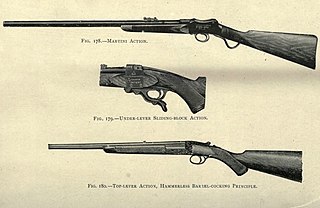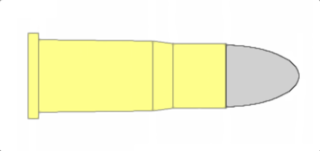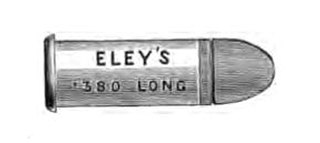
The .303 British or 7.7×56mmR, is a .303-inch (7.7 mm) calibre rimmed tapered rifle cartridge. The .303 inch bore diameter is measured between rifling lands as is the common practice in Europe which follows the traditional black powder convention.

The double rifle, also known as a double-barreled rifle, is a rifle with two barrels mounted parallel to each other that can be fired simultaneously or sequentially in quick succession. Synonymous with big game hunting found primarily in Africa and Asia, the double rifle is a sporting weapon with very little military heritage.
The .577 Nitro Express is a large-bore centerfire rifle cartridge designed for the purpose of hunting large game such as elephant. This cartridge is used almost exclusively in single-shot and double express rifles for hunting in the Tropics or hot climates in general and is a cartridge associated with the golden age of African safaris and Indian shikars.
.450 Nitro Express also known as the .450 Nitro Express 31⁄4-inch is a rifle cartridge designed for hunting dangerous game such as elephant, rhino, cape buffalo, lion, and leopard. This cartridge is used almost exclusively in double rifles for hunting in the tropics or hot climates in general and is associated with the Golden Age of African safaris and Indian shikars.
The .240 Magnum Rimless Holland & Holland is a centrefire sporting rifle cartridge developed in English gunmakers Holland & Holland no later than 1919, primarily for use in hunting deer and plains game.

.22 caliber, or 5.6 mm, refers to a common firearms bore diameter of 0.22 inch (5.6 mm) in both rimfire and centerfire cartridges.

The rook rifle, originally called the rook and rabbit rifle, is an obsolete English single-shot small calibre rifle intended for shooting small game, particularly rook shooting.
The .333 Jeffery and .333 Jeffery Flanged are medium-bore rifle cartridges developed by W.J. Jeffery & Co and introduced in 1908.
The .400/350 Nitro Express, also known at the .400/350 Nitro Rigby, is a medium bore rifle cartridge developed by John Rigby & Company.
The .450 Black Powder Express, also known as the .450 31⁄4-inch BPE, was a popular black powder cartridge in the late 19th and early 20th century.

The .255 Jeffery Rook / 6.5x29mmR, also known as the .255 Jeffery Rook Rifle, is an obsolete small bore intermediate firearm cartridge.
The .300 Sherwood / 7.6x39mmR, also known as the .300 Extra Long and the .300 Westley, is an obsolete intermediate centerfire rifle cartridge developed by Westley Richards.

The .300 Rook / 7.6x30mmR, also known as the .295 Rook, is an obsolete intermediate centerfire rifle cartridge.

The .297/250 Rook / 6.4x21mmR is an obsolete centerfire rifle cartridge developed by Holland & Holland.

The .360 No. 5 Rook / 9.2x27mmR is an obsolete centerfire rifle cartridge.

The .380 Long [9.8 x 24mmR], also known as the .380 Rook rifle, is an obsolete centerfire rifle cartridge.

The .461 No 1 Gibbs and the .461 No 2 Gibbs are two obsolete proprietary rifle cartridges developed in 19th century Britain.

The .297/230 Morris Short and .297/230 Morris Long are two obsolete centerfire firearm cartridges developed as sub-caliber training rounds for the British Martini–Henry rifle.
The .375/303 Westley Richards Accelerated Express, also known as the .375/303 Axite, is an obsolete medium bore rifle cartridge.
The 20/577 Alexander Henry, also known as 20/577 Express, is an obsolete rifle cartridge.










